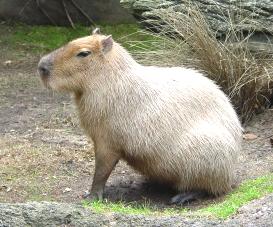 [Capibara, Chiguiro, Carpincho
(Spanish); Capivara (Portuguese); Hydrochoerus hydrochaeris]
[Capibara, Chiguiro, Carpincho
(Spanish); Capivara (Portuguese); Hydrochoerus hydrochaeris]
Native to South America, the capybara is the largest rodent alive today and grows to over 140 pounds. Extinct capybaras were much larger with Josephoartigasia monesi exceeding 2200 pounds. Capybaras are doing well today and have a conservation status of LC (Least Concern) though hunting them has been restricted in some areas where populations have declined.
Capybaras are semi-aquatic, living in most of South America but avoiding the Andes mountains. They are easy going and allow people to pet them but they do not make good pets because they are unhappy taken from their family, and they occasionally bite and get pushy. Photo © i0099
More on Rodents & Rabbits.
Back in 2006/2007 a new sign was purchased for the California Visitors Information Center along the Santa Monica freeway. These signs normally feature the silhouette of a California bear. Unfortunately, the painter of this sign wasn't too familiar with bears. By time it was replaced the silhouette he painted had been identified as that of a capybara.
There are actually plenty of capybaras on exhibit in Southern California, particularly at the Santa Anna and Santa Barbara Zoos, as the weather here is highly suitable for them. There may be some in the wild in Louisiana.
In South America capybaras are eaten and are reputed to be very much like pork. The meat is often dried, salted, shredded and seasoned. Capybara meat is particularly popular during Lent because the Catholic Church has identified these semi-aquatic rodents as fish, and fish is allowed during Lent. While I'm sure someone in Los Angeles sells capybara, I haven't found any yet.
Capybaras have very tough hide which is used to make a durable leather.
I know of no unusual risks in eating capybara except being bitten by one or pummeled by animal enthusiasts with whom they are quite popular.